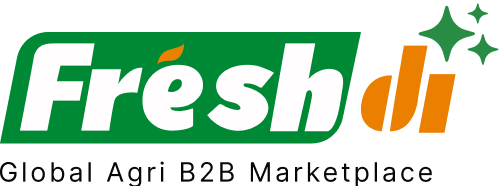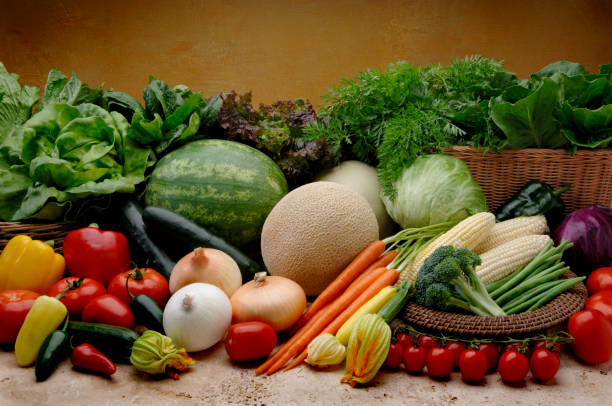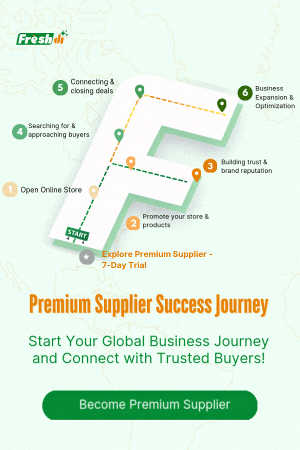Introduction – Current State of Play: The Vegetable Sector in China
China’s vegetable industry is in the spotlight in 2025, with several transformative developments reshaping how businesses source and distribute produce. From sweeping policy changes to surging consumer demand for organic options, and from technological leaps in cold-chain logistics to extreme weather events disrupting supply lines—the market is anything but static.
The Chinese government is doubling down on food security, sparking policy reforms that support domestic production and reduce dependency on imports. Meanwhile, global demand shifts and intensified climate events—like Typhoon Bebinca, the most powerful storm to hit the Yangtze River Delta in decades—are testing the resilience of supply chains. These rapid changes mean that companies sourcing vegetables from China must stay agile, informed, and digitally connected.
Platforms like Freshdi are becoming vital for real-time market intelligence, supplier verification, and navigating RFQ (Request for Quote) trends that shift with every new policy or storm. Let’s unpack everything you need to know about the current vegetable market in China and the top suppliers to watch in Q2 2025.
Deep Dive – What’s Making Headlines? Key Recent News & Impacts
1. Explosive Market Growth
In 2025, China’s vegetable market is expected to rake in a staggering $171.31 billion, with an annual growth rate of 7.51% projected through 2030. What’s behind this boom? A growing urban population that’s getting more health-conscious. Organic vegetables, in particular, are flying off the shelves—urban sales are up 30%, and the organic segment now dominates with a 61.54% market share.
(Source, Source)
2. Supply Chain Upgrades: Cold-Chain Logistics Expansion
Fresh produce needs to stay fresh, right? That’s where cold-chain logistics comes in. China’s cold-chain sector hit a value of 2.21 trillion yuan (around $306.6 billion) in Q1 2025—a 4% increase year-over-year. With online sales of fruits and vegetables up 15% and frozen food sales up 10%, these logistics upgrades are reducing waste and speeding up delivery.
(Source)
3. Foreign Investment Flooding In
China is now a magnet for global investors, especially in supply chain tech and agriculture. Favorable government policies and a strategic focus on self-sufficiency are attracting multinational companies looking for long-term stability.
(Source)
4. Climate Change: The Wild Card
Mother Nature is flexing her muscles. Typhoon Bebinca—Shanghai’s worst storm in over 70 years—wreaked havoc on crop production and logistics. This led to a surge in vegetable prices, highlighting the urgent need for resilient infrastructure and better risk management strategies.
(Source)
Top 3 Verified Vegetable Suppliers in China – Adapting to Today’s Market
Choosing the right supplier in today’s fast-paced market means looking beyond price. Certifications, global reach, and adaptability to current conditions are crucial. Based on buyer reviews, export records, and performance on Freshdi, here are the top three vegetable suppliers in China in Q2 of 2025:
1. Qingao Harthn-Ritune Corp., Ltd.
- Known For: IQF (Individually Quick Frozen) cauliflower and a wide range of frozen vegetables.
- Why They Stand Out: Leveraging advanced freezing technology, this supplier ensures consistent quality and long shelf life—perfect for export markets.
- Certifications: HACCP, ISO, and FDA-approved.
2. Qingdao DSF Foodstuff Co., Ltd.
- Known For: Frozen taro and peeled vegetable products.
- Why They Stand Out: Exceptional processing facilities and a reputation for cleanliness and safety.
- Global Reach: Strong ties with distributors in Southeast Asia and Europe.
3. Ningxia Zhongning Chunqi Wolfberry Technology Co., Ltd.
- Known For: Premium-grade fresh Chinese garlic.
- Why They Stand Out: Direct-from-farm sourcing and an emphasis on organic farming methods.
- Certifications: Organic, GAP (Good Agricultural Practices), and more.
Dynamic Ranking Note: Rankings can shift rapidly based on supplier performance, buyer reviews, and RFQ volume. Platforms like Freshdi feature dynamic rankings such as “Supplier of the Month” or “Top Exporter of the Quarter,” giving buyers real-time insights into who’s leading in quality and reliability.
Market Navigation – Strategic Responses to The Prevailing Vegetable Landscape in China
Opportunities for Global Buyers
- Organic Is King: With over 60% of the market now focused on organic produce, there’s massive potential for exporters and importers alike to ride the organic wave.
- E-commerce Boom: Online grocery shopping isn’t a trend—it’s the new normal. In 2023, online platforms made up 25% of fruit and vegetable sales, compared to just 5% in 2015. This channel creates new entry points for businesses of all sizes.
- Greenhouse Gains: China’s greenhouse farming covers 4 million hectares, offering year-round supply and consistent quality—a dream for buyers seeking reliability.
Key Risks to Watch
- Weather Woes: From typhoons to droughts, climate events can disrupt supply chains overnight. Flexibility and backup plans are a must.
- Environmental Degradation: With 20% of arable land suffering from salinization and erosion, long-term supply could be under threat.
- Food Safety Concerns: Past scandals have led to tighter regulations. Suppliers must now meet stricter standards, pushing the demand for verified and certified partners.
Smart Sourcing Strategies
- Go Direct to the Source: Building relationships with farmers or co-ops ensures traceability, reduces costs, and boosts reliability.
- Invest in Tech: Precision farming and smart irrigation aren’t just buzzwords—they’re essentials for improving yield and reducing waste.
- Diversify Channels: Don’t put all your eggs (or carrots) in one basket. Use both traditional retail and e-commerce to buffer against disruptions.
Short-Term Outlook
Despite the bumps in the road, the future looks green. Rising incomes, urban expansion, and health trends will keep demand high. However, businesses must be proactive—weather events and regulatory changes can cause sudden shifts. Platforms like Freshdi allow companies to adapt quickly by providing real-time data, supplier updates, and RFQ alerts that align with current events.
Conclusion – Key Takeaways for Businesses in a Rapidly Evolving Market
The Chinese vegetable market in Q2 2025 is a mix of booming demand, cutting-edge logistics, and unpredictable challenges. From the rise of organic vegetables to the impact of extreme weather and evolving government policies, businesses need to be both informed and adaptable.
Here’s the game plan:
- Stay current with market trends and policy shifts.
- Prioritize suppliers with strong certifications and real-time adaptability.
- Leverage platforms like Freshdi for dynamic supplier rankings, RFQ trend alerts, and verified sourcing partners.
- Diversify your sourcing and distribution strategies to weather the storms—both literal and figurative.
The vegetable market in China is fertile ground for opportunity, but only if you’re ready to grow with it.
Themed Buyer Checklist: Navigating China’s Vegetable Market
- ✅ Verify supplier certifications (HACCP, Organic, GAP)
- ✅ Monitor weather and logistics updates
- ✅ Use RFQ tools on platforms like Freshdi for demand insights
- ✅ Establish direct relationships with growers/co-ops
- ✅ Diversify your sourcing and distribution channels
- ✅ Watch dynamic rankings to see who’s performing best right now
Looking Ahead: What’s Next for China’s Vegetable Market?
The next few quarters will likely bring:
- More foreign investment in high-tech agriculture
- Stronger e-commerce infrastructure for produce delivery
- Tighter food safety regulations
- Increased consumer demand for traceable, organic food
Businesses that combine agility with data-driven decisions—especially using platforms like Freshdi—will be best positioned to capitalize on this growth.
FAQs
1. What’s driving the growth of China’s vegetable market in 2025?
A mix of rising health awareness, urbanization, and a surge in demand for organic produce is fueling growth. Government investments and better cold-chain logistics are also playing a big role.
2. How do I find verified vegetable suppliers in China?
Platforms like Freshdi are great for vetting suppliers. They offer verified profiles, buyer reviews, and certification details.
3. What are the top vegetables being exported from China in 2025?
Garlic, cauliflower, taro, and frozen mixed vegetables are among the top exports this quarter. Demand for organic and greenhouse-grown varieties is also climbing.
4. How are weather events like typhoons affecting supply chains?
Extreme weather disrupts both production and logistics, causing price spikes and delivery delays. Businesses need contingency plans and real-time data to adjust quickly.
5. Why is Freshdi recommended for sourcing vegetables from China?
Freshdi offers real-time supplier data, RFQ trend tracking, and dynamic rankings. It helps buyers stay ahead of market shifts and easily connect with trustworthy suppliers.
References
- Statista – China Vegetable Market Outlook
- GlobeNewswire – China Fruit & Vegetable Market Forecast
- Bastille Post – Cold-Chain Expansion Q1 2025
- Beijing Post – Foreign Investment in Supply Chain
- FreshPlaza – Vegetable Prices Soar Due to Weather
- CSIS – China’s Food Security
- Astute Analytica – China Fruits and Vegetables Market
- Mordor Intelligence – China Vegetable Seeds Market
- Wiley Online Library – Direct Farmer Engagement in China


